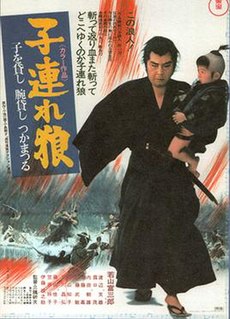Zanbatō is an especially large, curved type of fictional sword used by characters in Japanese anime and manga. Books written about nihontō make no references to zanbatō as being actual swords used in feudal Japan. The name zanbatō translates to "horse-slaying sword" or "horse-chopping saber". Original examples came from Song Dynasty China and were employed by anti-cavalry infantry in the same manner.

Lone Wolf and Cub is a Japanese manga series created by writer Kazuo Koike and artist Goseki Kojima. First published in 1970, the story was adapted into six films starring Tomisaburo Wakayama, four plays, a television series starring Kinnosuke Yorozuya, and is widely recognized as an important and influential work.
Yuki, Yūki or Yuuki may refer to:

Shogun Assassin is a 1980 jidaigeki film directed by Robert Houston.

Kazuo Koike was a prolific Japanese manga writer (gensakusha), novelist, screenwriter, lyricist and entrepreneur. He is best known for his violent, artful seinen manga, notably Lone Wolf and Cub, Lady Snowblood and Crying Freeman, which – along with their numerous media adaptations − have been credited for their influence on the international growth of Japanese popular culture.

Tomisaburō Wakayama, born Masaru Okumura, was a Japanese actor best known for playing Ogami Ittō, the scowling, 19th-century ronin warrior in the six Lone Wolf and Cub samurai movies.

Samurai Executioner, known in Japan as Kubikiri Asa (首斬り朝), is a 10-volume manga created by writer Kazuo Koike and artist Goseki Kojima, the same team that created the popular Lone Wolf and Cub series. The series was first serialized in Japan, from 1972–1976. Samurai Executioner is set earlier than Lone Wolf and Cub, with the main character of the former series appearing in a chapter of the latter.
A lone wolf is a wolf not belonging to a pack.

Lone Wolf and Cub: Sword of Vengeance is a 1972 Japanese chambara film directed by Kenji Misumi. The film tells the story of Ogami Ittō, a wandering assassin for hire who is accompanied by his young son, Daigoro. It is the first in a series of six films in the Lone Wolf and Cub series.

Lone Wolf and Cub: Baby Cart at the River Styx is the second in a series of six Japanese martial arts films based on the long-running Lone Wolf and Cub manga series about Ogami Ittō, a wandering assassin for hire who is accompanied by his young son, Daigoro.

Lone Wolf and Cub: Baby Cart to Hades, is the third in a series of six Japanese martial arts films based on the long-running Lone Wolf and Cub manga series about Ogami Ittō, a wandering assassin for hire who is accompanied by his young son, Daigoro.

Lone Wolf and Cub: Baby Cart in Peril is the fourth in a series of six Japanese martial arts films based on the long-running Lone Wolf and Cub manga series about Ogami Ittō, directed by Buichi Saitō.

Lone Wolf and Cub: Baby Cart in the Land of Demons is the fifth in a series of six Japanese martial arts films based on the long-running Lone Wolf and Cub manga series about Ogami Ittō, a wandering assassin for hire who is accompanied by his young son, Daigoro.

Lone Wolf and Cub: White Heaven in Hell is the final entry in a series of six Japanese martial arts films based on the long-running Lone Wolf and Cub manga series about Ogami Ittō, a wandering assassin for hire who is accompanied by his young son, Daigoro. Although this is the last film in the series, it does not end the story or include the conclusion of the series as written in the manga.

Yorozuya Kinnosuke (萬屋錦之介) was a Japanese kabuki actor. Born Kin'ichi Ogawa, son of kabuki actor Nakamura Tokizō III, he entered kabuki and became the first in the kabuki tradition to take the name Nakamura Kinnosuke. He took on his guild name (yagō) Yorozuya as his surname in 1971.
The Edo period of the history of Japan is the setting of many works of popular culture. These include novels, stage plays, films, television shows, animated works, manga, and video games. Major events of the period, such as the Siege of Osaka, Shimabara Rebellion, and the decline and fall of the Tokugawa shogunate figure prominently in many works. Historical and fictional people and groups of the period, including Miyamoto Musashi, Izumo no Okuni, Yagyū Jūbei Mitsuyoshi, the fictional Isshin Tasuke, Yui Shōsetsu, Matsuo Bashō, Tokugawa Mitsukuni, Ōoka Tadasuke, Tōyama Kagemoto, the Forty-seven Ronin, Sakamoto Ryōma, Katsu Kaishū, and the Shinsengumi, as well as the fifteen Tokugawa shoguns were active for much or all of their public lives and are dramatized in works of popular culture. The cultural developments of the times, including kabuki, bunraku, and ukiyo-e, and practices like sankin kōtai and pilgrimages to the Ise Shrine, feature in many works set in Edo Japan.
Kogi is a state in Nigeria.
Lone Wolf and Cub: Final Conflict is a 1993 Japanese film directed by Akira Inoue. It is based on Kazuo Koike's manga series Lone Wolf and Cub. Masakazu Tamura played Ogami by Koike Kazuo's strong request. Koike produced the film on the theme of parent-child love, not action as with past Lone Wolf and Cub films and television drama series.











